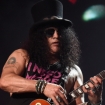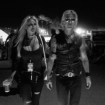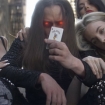Revolver has teamed up with The Living, Duff McKagan's early punk band, for an exclusive Translucent Ruby vinyl variant of their newly issued album The Living: 1982. Quantities are extremely limited — so order yours before they're gone!
"It was a really magical moment," Duff McKagan says, talking to Revolver about his early Eighties Seattle punk band, the Living. And it's a moment that, for the first time, fans can now experience via The Living: 1982 — a new collection of seven McKagan-penned originals, recorded in one session 39 years ago.
The mini-album — which is being released via Pearl Jam guitarist Stone Gossard's Loosegroove Records imprint — is a short, sharp blast of teenage angst that rages against everything from war ("Live By the Gun") and addiction ("No Thanks") to suicide (Life is a Terror") and socio-economic inequality ("I Want"). The Living: 1982 represents one of the earliest recorded forays of McKagan, who here plays guitar alongside drummer Greg Gilmore (later of Seattle hard rock merchants Mother Love Bone), singer John Conte and bassist Todd Fleischman.
Beyond that, it's also a vital document of the vibrant Seattle punk scene, which predated the city's more celebrated grunge movement by several years, and also influenced many of the musicians (Gossard among them) who would go on to experience massive mainstream success.
As for McKagan, though he played in other area punk acts (the Fastbacks and 10 Minute Warning among them) before eventually heading south to L.A. to find fame and fortune with Guns N' Roses, the Living holds a special place in his heart. "The band gave me confidence, because these were my songs," he says. "It really helped to form me as a musician and a songwriter, and convinced me this was what I was going to do forever."
McKagan sat down with Revolver to talk about those formative days with the Living, as well as the new release that finally celebrates what has been a somewhat forgotten link in both his personal history and the larger Seattle punk rock movement. As he makes clear in the following interview, while the Living burned bright and fast, they did plenty of ass-kicking — both figurative and literally — along the way.

HOW DID THE LIVING: 1982 COME TO BE?
DUFF McKAGAN So Stone Gossard, obviously he was in a band, Mother Love Bone, with Greg Gilmore. And he got wind that there was a recording. And this is something I just learned, but to Stone, the Living was this band that made everything clear to him and pointed him toward, like, "I want to do rock 'n' roll." I never knew that this whole fucking time. So Stone has his label, and he started talking with Greg about doing something with the recordings. Then Greg got ahold of me: "Stone wants to put the Living out." And it took me back. It was really cool for me to hear, and I think it'll be cool for other people, too. It's a link in Seattle rock, from the early punk stuff to what was to come later with Soundgarden and Sub Pop and all that.
TO THAT POINT, PEOPLE ASSOCIATE SEATTLE SO CLOSELY WITH GRUNGE. BUT THE CITY'S PUNK MOVEMENT WAS SIGNIFICANT IN ITS OWN RIGHT.
Yeah. And you know, Stone was there. [Chris] Cornell was there. There were guys there that you would know. But it was a small scene. And so were all the scenes. Like, Vancouver had DOA and the Subhumans, really cool bands, but it was small there, too. And recently I watched the Go-Go's documentary, and they were talking about how small the scene was in L.A. So you had a bunch of small scenes. But in Seattle, I learned a lot from it because everybody had a band, and you'd share gear, share rehearsal spaces, share riffs and bands that you were into — it was very supportive.
And I was young – you know, '79 is probably when I went to my first gig and I was like, what, 14? Formed a band a week later, wrote a song, made a single, it was the first thing I ever did. I sang that song and my voice hadn't changed yet. So it was a bunch of young people just figuring it out. We weren't 21 — we weren't even close to 21. We couldn't go play bars. So you'd play at people's houses or rent a little union hall and throw gigs. It was just a self-supporting, cool fucking scene, with a lot of cool, cool bands.
CAN YOU TALK A BIT MORE ABOUT WHAT THAT SCENE WAS LIKE?
Well, back then punk rock was still the super outlier, right? Like, frat boys or whatever would circle the block with their cars and beat up punkers. You stuck out that much. It happened to me twice, just getting beat up by random groups of knuckleheads. You know, "Punk rock faggots!" But what that did to you was it made you feel more right in what you were doing. You were threatening knuckleheads, so you must be onto something, right?
But my point with that is bands had to be physically tough. And if you see the artwork for the cover of the release, it's a photo of Todd, our bass player. He was this big dude who did martial arts, back when martial arts and MMA was not even spoken about. And I remember there was a gig we played where these guys, they were very drunk, came to beat up the punkers. But what they didn't realize was that the punk bands were used to that kind of shit. And Todd was this big gnarly fucker. So he beat up six guys after the show. Six guys. And the last guy was on his knees, pleading "No! I'm sorry!"
SEEMS LIKE A GOOD GUY TO HAVE IN YOUR BAND.
Well, you know, it's not like we wanted to be tough. Punk was like this artistic thing — the last thing you wanted to do was be a jock or have to fight. But you did have to fight, and you knew that back then. And that really went into Guns N' Roses as well. That was still the mentality when we were in the first couple of years of being a band in Hollywood. Because Hollywood was a lot more gnarly than it is now. You had to be tough — physically tough. I think that came from the punk thing and being kind of ostracized for the way you looked. Nowadays punk is just sold in malls, of course. And I have no comment about that, but it is what it is. But I thought it was cool as fuck in 1979 and I thought everybody should know about it. And now everybody does. And that's cool.
IT MUST BE SUCH A TRIP FOR YOU TO LISTEN TO THESE SONGS ALL THESE YEARS LATER. LIKE IN "TWO GENERATION STAND" WHERE JOHN SINGS "DEATH TO THE OLD," IT STRUCK ME AS FUNNY BECAUSE, NOT THAT YOU'RE OLD NOW, BUT YOU GUYS WERE PROBABLY REFERRING TO SOMEONE WHO'S, LIKE, 30.
Totally. Even 28! But you know, even then there was a sense of humor in punk rock. And writing songs like that, there was the hippie stuff before us, and what was the saying? "Don't trust anybody over 30"? Then the punk rock thing was "Don't trust a hippie." Because they were now over 30. So we knew we were in that sort of revolving door thing, pointing at the old people. But yeah, when you're 16, 17 years old, you don't think you're going to live past 30. So that's that.
WHEN YOU MADE THE MOVE TO L.A. A FEW YEARS LATER, GREG GILMORE, WHO AFTER THE LIVING ALSO PLAYED WITH YOU IN 10 MINUTE WARNING, WENT WITH YOU, CORRECT?
He came with me … ish. We came down within the same week or two. He was still looking for something to do musically, but I think once he got there he was like, "Eh, this ain't for me." For me, I just didn't know what else to do. Once I'd made the decision to go down there I wasn't gonna come back to Seattle without at least knowing exactly what I was going to do. And it turned out I didn't come back until the Nineties. But it was a good thing Greg went back, because Mother Love Bone happened. So everything happens for a reason.
YOU JOINED UP WITH GUNS N' ROSES NOT LONG AFTER. AND WHILE GUNS CLEARY HAD A PUNK EDGE, YOU HAD BEEN PRETTY DEEP IN THAT WORLD FOR MANY YEARS, AND ON A VERY GRANULAR LEVEL. DID YOU FIND YOURSELF PUTTING ANY OF YOUR PUNK ROOTS IN YOUR BACK POCKET?
Well just remember, things happened in lightning-speed time. By 1984, 1981 felt like it was a decade before. Especially at that young age. And for me, by '84, I mean, punk was dead. That's when the bourbon jocks had come into the scene, shaved their heads and were doing, like, Nazi shit. They thought slam dancing was like fighting. They were bringing knives. The whole point got lost. There were punk rock gangs. Like, gangs? By definition, that's not punk rock. Because punk rock was about being an individual.
So really there was a sea change. I got to L.A., and Ron Reyes from Black Flag, he was my bro, and he had long hair. We were going to start a band, we were listening to Prince and Hanoi Rocks. And Izzy [Stradlin], when he lived across the street from me in Hollywood he looked like Johnny Thunders. So I was like, "Okay, Johnny Thunders guy, perfect." And when I saw Slash's ad in the paper... his name was Slash. I put it with Slash Records, right? So I was thinking, here's a punker dude like me who's looking for the next thing. So I think by the time of Guns N' Roses, it was like, "Punk is dead, whatever's next is going to be on our shoulders. We have to invent it." So I didn't have to put anything in my back pocket. Actually, it was the opposite — I was able to bring the good parts of that into the band. And then we went and did our own thing.









